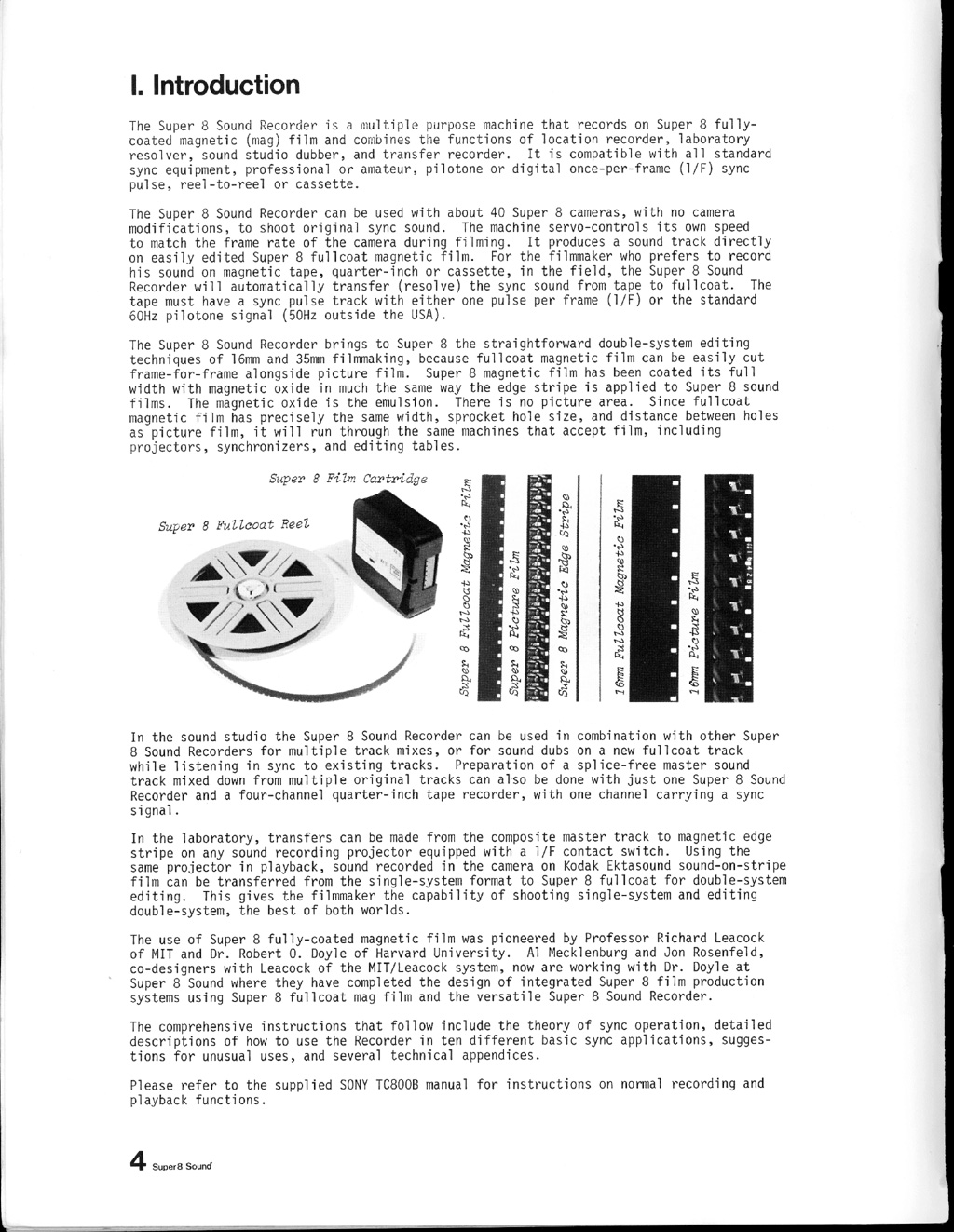
previous page | Page 4 | next page
I. Introduction
The Super 8 Sound Recorder is a multiple purpose machine that records on Super 8 fully coated magnetic (mag) film and combines the functions of location recorder, laboratory resolver, sound studio dubber, and transfer recorder. It is compatible with all standard sync equipment, professional or amateur, pilotone or digital once-per-frame (l/F) sync pulse, reel-to-reel or cassette.
The Super 8 Sound Recorder can be used with about 40 Super 8 cameras, with no camera modifications, to shoot original sync sound. The machine servo-controls its own speed to match the frame rate of the camera during filming. It produces a sound track directly on easily edited Super 8 fullcoat magnetic film. For the filmmaker who prefers to record his sound on magnetic tape, quarter-inch or cassette, in the field, the Super 8 Sound Recorder will automatically transfer (resolve) the sync sound from tape to fullcoat. The tape must have a sync pulse track with either one pulse per frame (l/F) or the standard 60Hz pilotone signal (50Hz outside the USA).
The Super 8 Sound Recorder brings to Super 8 the straightforward double-system editing techniques of l6mm and 35mm filmmaking, because fullcoat magnetic film can be easily cut frame-for-frame alongside picture film. Super 8 magnetic film has been coated its full width with magnetic oxide in much the same way the edge stripe is applied to Super 8 sound films. The magnetic oxide is the emulsion. There is no picture area. Since fullcoat magnetic film has precisely the same width, sprocket hole size, and distance between holes as picture film, it will run through the same machines that accept film, including projectors, synchronizers, and editing tables.
In the sound studio the Super 8 Sound Recorder can be used in combination with other Super 8 Sound Recorders for multiple track mixes, or for sound dubs on a new fullcoat track while listening in sync to existing tracks. Preparation of a splice-free master sound track mixed down from multiple original tracks can also be done with just one Super 8 Sound Recorder and a four-channel quarter-inch tape recorder, with one channel carrying a sync signal.
In the laboratory, transfers can be made from the composite master track to magnetic edge stripe on any sound recording projector equipped with a l/F contact switch. Using the same projector in playback, sound recorded in the camera on Kodak Ektasound sound-on-stripe film can be transferred from the single-system format to Super 8 fullcoat for double-system editing. This gives the filmmaker the capability of shooting single-system and editing double-system, the best of both worlds.
The use of Super 8 fully-coated magnetic film was pioneered by Professor Richard Leacock of MIT and Dr. Robert 0. Doyle of Harvard University. Al Mecklenburg and Jon Rosenfeld, co-designers with Leacock of the MIT/Leacock system, now are working with Dr. Doyle at Super 8 Sound where they have completed the design of integrated Super 8 film production systems using Super 8 fullcoat mag film and the versatile Super 8 Sound Recorder.
The comprehensive instructions that follow include the theory of sync operation, detailed descriptions of how to use the Recorder in ten different basic sync applications, suggestions for unusual uses, and several technical appendices.
Please refer to the supplied SONY TC800B manual for instructions on normal recording and playback functions.